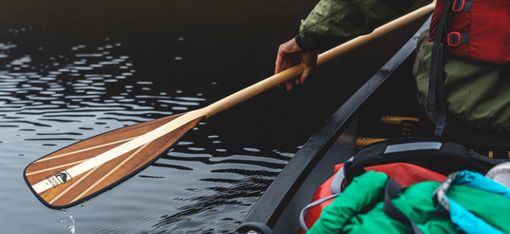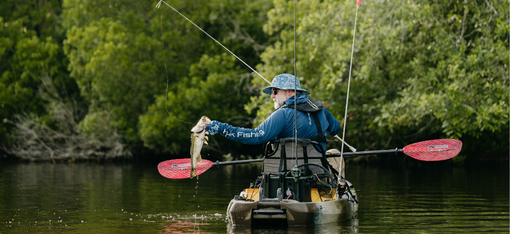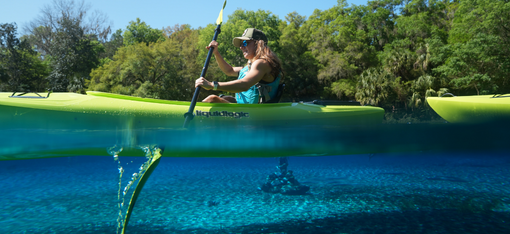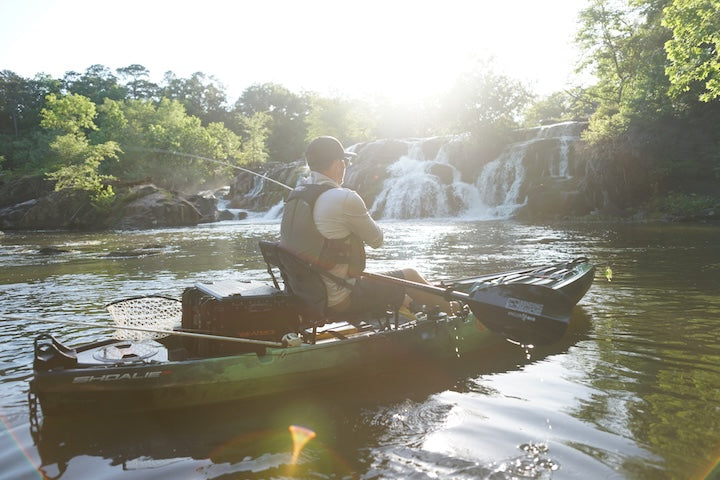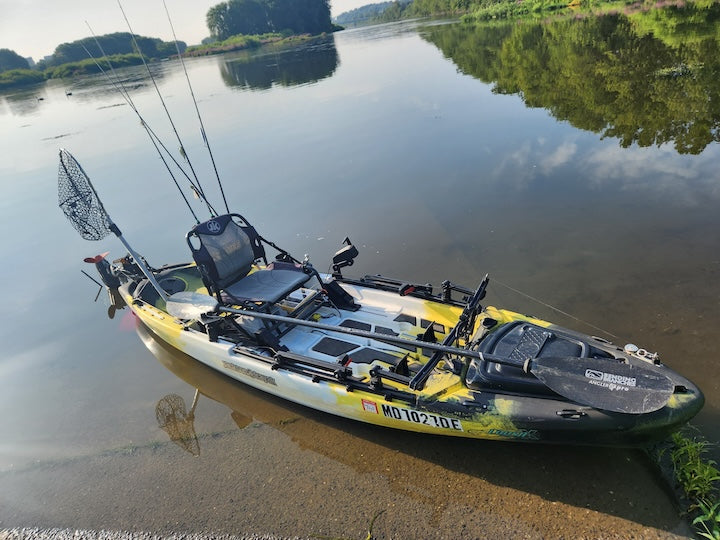How to Frog Fish Successfully from a Kayak
6-minute read
by Tyler Thiede
People seem to have a love-hate relationship with frog fishing. The ones who hate it just haven't figured it out or been properly taught. Or maybe it’s the smell of the swampy weed mats, the black mud of the lake or river, or the swarm of bugs.

My son and I frog fishing from our kayaks
For those of us who love it, we love the smell of that swamp. We embrace the bugs (with limitations—hence the DEET and head nets in my kayak's dry bag). We love the lines in the weed mats and duckweed.
Our senses of sight and sound are trained to find new and old blow-up holes to target. We love the rush of adrenaline as we hesitate, against every fabric of our instinct, before we set that hook. We love hauling in that unknown fish and unwrapping it from the weeds like a kid on Christmas morning.
I've written, done videos and helped clients (as a guide) with the standards of frog fishing before. Heavy rod, heavy reel, thick braid, the difference in frog types and colors, counting to three before setting the hook, et cetera.
Some important things are often overlooked when talking frog fishing from a kayak—the kayak, paddle and accessories. Though tackle and technique are extremely important, these three can help you physically, mentally, financially and with overall success.
Use a Fishing Kayak You Can Paddle
Let's be real—ideal frog fishing conditions are nasty by normal standards. It’s often swampy and shallow, with lots of weeds, and seemingly beautiful lily pads that tend to be anchored to the bottom by stems nearing the strength of steel.
As an avid frog fisherman, I’ve seen anglers in bass boats worth over $100,000 get frustrated and leave areas where I’m successfully frog fishing in my kayak. Thus my main kayak is very paddle-friendly.

My son, also addicted to frog fishing
Don’t get me wrong. I love wide pedal-driven kayaks. But since my style of choice is frog-friendly conditions I choose the Feelfree Moken 12.5v2 because it’s…
- Stable enough for me to stand in when needed
- Narrow enough to be efficient to cover large bodies of water
- Comfortable enough for my bad back to be seated for the better part of 12+ hours
- It has the features to handle the key accessories that make my outing successful
No matter the make or model you choose, make sure you can paddle it. Pulling weeds out of a motor or pedal system all day is not pleasant. Nor is running aground and hitting hidden wood with one. This leads me to the next most important tool in frog fishing fun: your paddle.
Importance of a Quality Kayak Fishing Paddle
I tell people, “Buy the most expensive paddle you can afford.” To which people respond, “What’s the difference?”

The Bending Branches Navigator Pro
Well, typically, the more you spend on the paddle, the lighter and more efficient it is. Having used a wide range of them, I can tell you with certainty there’s a massive difference between a $50 paddle and a $400 paddle when you spend a lot of time on the water.
My main paddle is the Bending Branches Angler Pro Carbon. It’s expensive, but is obscenely light and nearly bulletproof (I'm incredibly hard on my paddles when paddling and in transport, since I just toss them into the bed of my truck).
However, my favorite frog fishing paddle is the Bending Branches Angler Navigator. Not only does it have gorgeous hand-made wood blades (I’ve been to the factory multiple times and can personally confirm the blades are hand-made works of art), but it’s also very light.
The carbon shaft is exponentially lighter than aluminum or fiberglass alternatives. And the wood blades provide two major benefits over fiberglass or poly alternatives.
The wood blades of the Navigator are hand-crafted to be incredibly efficient. The natural flex of the wood not only helps with the efficiency but also makes them the quietest blades I've ever used on a paddle.
Paddling Stealth in the Swampy Shallows
This quietness is critical when trying to inch your way through swampy shallows in areas inaccessible by boats. Though the wood blades aren't lighter than the all-carbon blades of the Angler Pro Carbon, they do outperform them and the other blade materials in frog fishing situations.
It has to do with the smooth hand-crafted elegance of the blades. The weeds tend to slide off the edges and face of the paddle easier than the sharper carbon, fiberglass or plastic alternatives.
The smoother edges also help with stealth in vegetation. The smooth edges don't make the rubbing noise that sharper alternatives make when trying to crawl through thick weeds.

“Navigating” the lily pads
This said, the thinner, sharper-edged poly, fiberglass or carbon blades can be used in thick vegetation if you modify your paddling technique. To mitigate noise and hang-ups with these paddles, hold the paddle so the tops are rotated slightly towards you and dip the blades shallower in the water. This allows more vegetation to slide under the blade with the stroke and reduces the amount that gets hung up on the tops of the blades.
With either type of paddle blade, to maintain your stealth clear the weeds with a simple roll of the paddle. This allows the weeds to fall off the blade whereas a more harsh shake of the blade causes extra motion or noise.
Accessories to Up Your Game
Frog fishing accessories are fairly simple. My key ones focus on boat placement, fish landing and hook removal.
For boat placement, I absolutely love my YakGadget Quick Stop shallow water anchor on my Feelfree Moken 12.5v2. I use it to stop me when pulling in a fish while in tight spots or to hold me in the wind. At a fraction of the price, weight and complexity of a powered shallow water anchor it holds me in position whenever I need it.
For landing the fish, I sometimes bring a net. However, being superstitious, I find nets to be bad luck. Though they’ve saved many fish for me, I typically go without and instead use a simple set of Fish Grips.
For bass I often use just my hands, then use Fish Grips to secure them and let them calm down before grabbing a tournament photo. But I always carry them because I often find myself catching toothy fish like Northern Pike or Dogfish/Bowfin when frog fishing. I know from experience a Northern Pike tooth to the thumb makes a bloody mess susceptible to infection.
The hook removal aspect is very simple, a pair of "fishing" (needle nose) pliers. You’re waiting several seconds to set the hook when frog fishing, allowing the fish to pull the frog down before swallowing it. Inevitably you’ll get a hook deep in the mouth of a fish when doing this. Have a good pair of needle-nose pliers to help safely and quickly remove the hook from the fish.

My son with his frog fishing set-up
To Wrap It Up
In summary, frog fishing is hands-down my favorite method of fishing. Though it’s frustrating, people request I teach them how to frog fish far and above any other style.
The blowups, painful hesitation before setting the hook, hauling in the fish-plus-weeds, then unwrapping said fish from the weeds—it’s one of the most rewarding methods of fishing there is.
Choosing the right kayak, paddle and accessories can help make your experience more enjoyable…and much less frustrating.
Do you have paddle questions our friendly Customer Service Team can help you with today? Contact them: 715-755-3405 • [email protected]
More for you...




